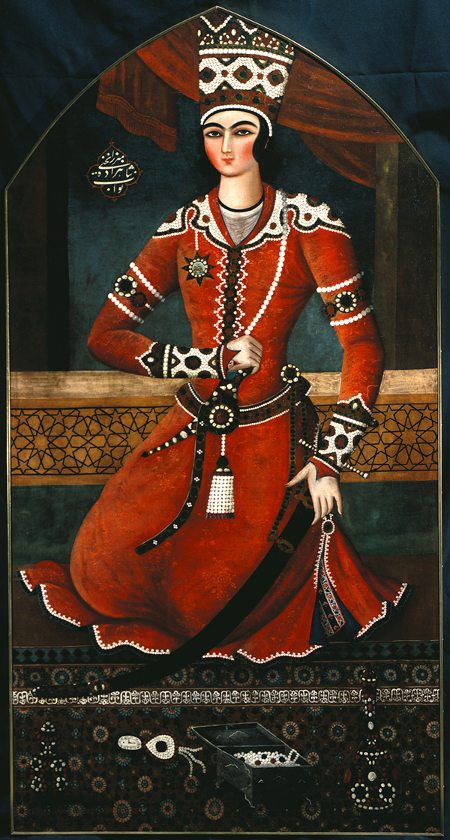An Image of Royal Power Attributed to Muhammad Hasan
In the history of portrait painting, it is fascinating to interpret what the artist is trying to convey about the sitter. Sometimes when the portrait is of a member of a ruling family, it’s pretty clear what the message is—power.
 |
| Attributed to Muhammad Hasan Afshar (active 1808–1840, Iran), Portrait of Prince Yahya, 1830s. Oil on canvas, 67" x 35" (170.2 x 88.9 cm). Image © 2024 Brooklyn Museum. (BMA-88) |
In this princely portrait, the influence of Peter Paul Rubens (1577–1640) and Rembrandt van Rijn (1606–1669) are evident in the vibrant, saturated colors. Like all royal portraits, the features of Prince Yahya (Shahzada Navvab Mirza Yahya) are highly stylized and the pose is formulaic. While there is an emphasis on monumentality and plasticity of the figure, the background contains the decorative arabesques and patterns typical of Persian painting throughout the centuries and space is depicted vertically.
Prince Yahya was one of forty-odd sons of Fath 'Ali Shah Qajar (died 1834), second ruler of the Qājār dynasty (1789–1925) and the successor of Aghā Muhammad Khān (1742–1797). This arched format of life-sized portrait was originally intended as architectural decoration. It would have been part a niche in a wall of the palace in Shiraz, Iran. Yahya became governor of Gilan province quite young. The pocket watch in the foreground of this portrait may be a symbol of the time of his appointment as governor.
The influx of Western influence into Iranian art, which began early in the Safavid dynasty (1501–1736), included the appropriation of oil on canvas during as an art medium the 1600s. Later, artists of the Zand dynasty (1751–1794) were versatile in adapting the Safavid genres of manuscript illustration, portraits, watercolors, and enamel work. They also perfected the art of large-scale oil painting in the Western manner.
Muhammad Hasan Afshar was a Qājār dynasty poet and painter who studied the painting of Europe. He was a court painter during the reigns of Fath 'Ali Shah Qajar, Mohammad Shah Qajar (1808–1848), and Naser al-Din Shah Qajar (1831–1896). Hasan was a member of the Afshar tribe from Urmia, Iran, who was known by the title Painter Laureate.
The Safavid dynasty ruled Iran until the first half of the 1700s. Their power waned between 1736 and the 1750s, when a former slave, Nadir Shah (died 1747), forcibly assumed kingship. Upon his death, his heirs were unable to consolidate power and were brushed aside by Karim Khān Zand (ruled 1751–1779). Karim Khān established the Zand dynasty and ruled from Shiraz until his death. He actively encouraged the continuation of arts from the Safavid period, partly in order to prop up the legitimacy of his dynasty.
Shiraz was not Karim Kāhn's capital, but he developed it into the center of Iranian artistic activity, building palaces, foritifcations, and mosques in emulation of the great Safavid ruler Shah Abbas (1571–1629). He actively encouraged the wall painting and mosaic decoration of public buildings. Karim Kāhn was also interested in the Safavid practice of documenting his reign through painting.
Upon the death of Karim Khān in 1779, Aghā Muhammad Khān of the Turkomen Qājār people tried to unify Iran, establishing the Qājār dynasty. During the Qajar period, the modernization of Iran began. Western technology, science, and educational methods were introduced into Iran. Unfortunately, Iran was caught between the territorial ambitions of the British and the Russians. Russia and Britiain took over territories historically part of Iran during Safavid times.
The Qājār rulers were corrupt and extravagant. However, it was their extravagance that led to a flourishing in European-influenced oil painting during the 1800s. Just as Safavid book illustration had been influenced by Western European models, so too did Qājār painters look to European painting for inspiration, primarily the Baroque period (ca. 1600–1750). Large-scale portrait painting reached its greatest development under the Qājār shahs, who gave lavish commissions for portraits of their family members.
Correlations to Davis programs: Explorations in Art 2E Grade 1: 2.1, 2.2, 2.3; Explorations in Art 2E Grade 2: 2.2; Explorations in Art 2E Grade 3: 1.1, 1.2, 1.3; Explorations in Art 2E Grade 4: 2.1; Explorations in Art 2E Grade 6: 6.2, 6.3; Experience Art: 7.1; A Personal Journey 2E: 6.4; A Community Connection 2E: 2.1; Discover Drawing 3E: chapter 7

Comments